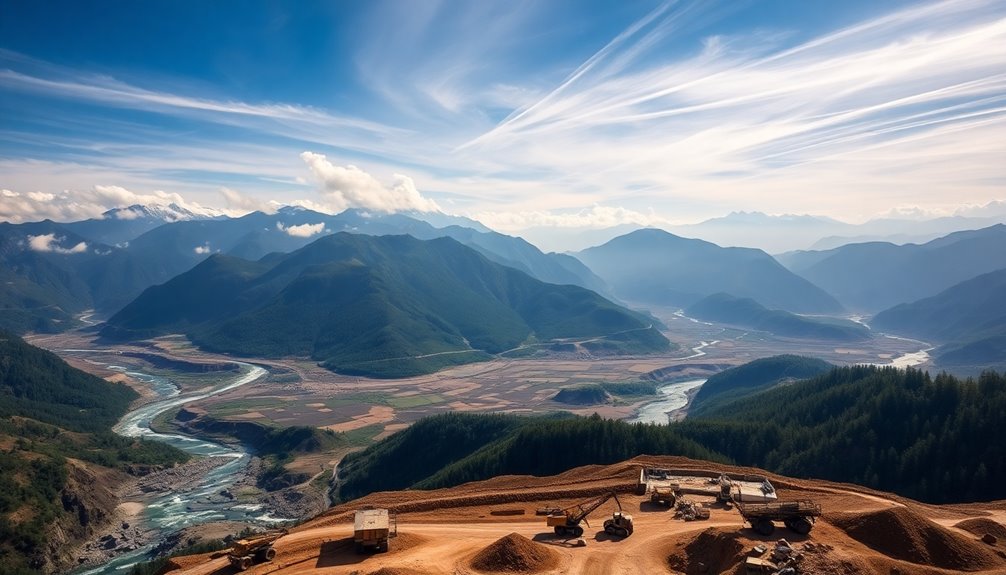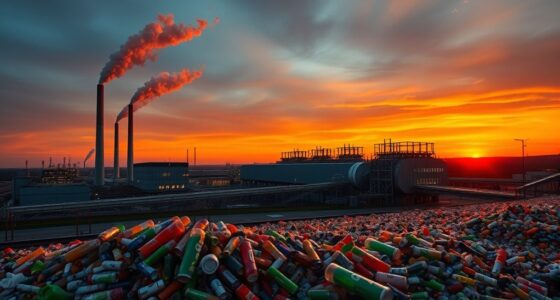New hydropower plans in the Hindu-Kush Himalaya region could unintentionally increase greenhouse gas emissions. While these projects aim to boost renewable energy, they may compromise environmental sustainability. Issues like sedimentation and unstable geological conditions add complexity to development efforts. Balancing energy production with ecological considerations is essential to avoid exacerbating climate change. If you want to explore how these challenges impact hydropower development further, there are interesting details waiting for you.
Key Takeaways
- New hydropower plans risk increasing greenhouse gas emissions if not designed with climate-resilient and environmentally friendly practices.
- Expanding hydropower infrastructure can lead to deforestation and land degradation, contributing to carbon release.
- Climate change may alter water flow patterns, undermining hydropower reliability and potentially increasing fossil fuel dependence.
- Sedimentation and unstable geological conditions can complicate hydropower projects, potentially leading to inefficiencies that raise emissions.
- Balancing hydropower expansion with sustainability and social equity is critical to prevent exacerbating greenhouse gas outputs.

As the "Water Tower of Asia," the Hindu Kush Himalaya region boasts an abundance of water resources, making it an ideal candidate for hydropower development. With extensive snow and ice reserves, the area feeds ten major river systems, supporting the livelihoods of 240 million people and impacting 1.65 billion downstream. This hydrological advantage is crucial for harnessing renewable energy, especially when you consider the pressing energy deficits in the region, where 72% of energy comes from non-renewable sources. Additionally, the region's immense hydropower potential can play a significant role in meeting the growing urban energy demands.
However, the region faces significant challenges due to climate change. By 2100, around a third of its glaciers may melt, which could severely affect hydropower sustainability. Altered precipitation patterns are already affecting river flows, raising concerns about the reliability of hydropower generation. You might also notice an increase in extreme weather events, like floods and glacial lake outburst floods, which threaten existing hydropower infrastructure. Given these realities, water flow could peak by 2050, then decline, posing a significant risk to future hydropower projects.
The impacts of climate change threaten the sustainability and reliability of hydropower in the region.
Despite these challenges, there are promising initiatives underway. For instance, over 300 micro-hydropower stations in Pakistan provide electricity to 1.5 million homes, showcasing the potential for small-scale implementation.
However, the road ahead isn't without hurdles. Sedimentation and unstable geological conditions complicate infrastructure development, and improving technical capabilities is essential for successful projects.
Balancing hydropower expansion with sustainability goals is crucial. While tapping into hydropower could address energy deficits, it's vital to ensure that these efforts don't inadvertently accelerate greenhouse gas emissions.
You must consider how to make hydropower projects climate-resilient and environmentally friendly, ensuring that they contribute to social equity and ecological balance. The future of hydropower in the Hindu Kush Himalaya hinges on navigating these complexities while leveraging its remarkable water resources.
Frequently Asked Questions
How Do Hydropower Projects Affect Local Communities in the Region?
Hydropower projects can significantly impact local communities. You might face displacement as construction often leads to the loss of homes without fair compensation.
There's also the risk of cultural disruption, as traditional ways of life can be affected. Moreover, while these projects can create jobs, the benefits mightn't reach you or your community equally.
Often, local voices aren't heard in decision-making, leading to resistance and concerns about environmental consequences.
What Are the Potential Ecological Impacts of New Hydropower Developments?
New hydropower developments can significantly impact local ecosystems.
You'll see land submersion leading to habitat loss and altered biodiversity. Dams can block fish migration paths, disrupting aquatic life.
Changes in water quality and flow patterns may harm both terrestrial and aquatic organisms. Additionally, flooding and infrastructure development transform landscapes, threatening species reliant on original habitats.
In short, these projects pose serious ecological challenges that can affect the health of entire ecosystems.
Are There Alternative Energy Solutions Being Considered in the Region?
What if your community could thrive on clean, renewable energy? In the region, decentralized solar solutions are gaining traction as a viable alternative.
You'll find that solar power not only enhances energy access in remote areas but also boosts agricultural productivity.
How Will Climate Change Influence Hydropower Viability in the Himalayas?
Climate change significantly influences hydropower viability in the Himalayas.
You'll see increased hazards like landslides and floods, destabilizing infrastructure. Glacial melt alters streamflow patterns, reducing energy production, especially during the pre-monsoon season.
While some areas might experience higher flows later in the year, the overall unpredictability complicates operations.
To ensure sustainability, you'll need to adopt climate-resilient practices and optimize reservoir management to adapt to these changing conditions effectively.
What Role Do Local Governments Play in Hydropower Project Approvals?
Local governments play a crucial role in hydropower project approvals. They establish zoning codes that dictate land use and require special permits or zoning amendments, affecting how quickly projects can move forward.
By engaging with community stakeholders early, you can foster acceptance and address concerns. Additionally, local agencies must ensure compliance with environmental regulations, coordinating with state agencies to oversee comprehensive project assessments and approvals effectively.
Your involvement and understanding of these processes are vital for success.
Conclusion
As you gaze upon the towering peaks of the Hindu-Kush Himalaya, remember that the river's flow can be both a lifeline and a peril. Just like a double-edged sword, new hydropower plans promise energy but could unleash a torrent of greenhouse gases. It's a delicate balance, akin to a tightrope walker straddling two cliffs. You hold the power to choose: harness the river wisely or let its fury spill forth, shaping a future you may not want to see.









